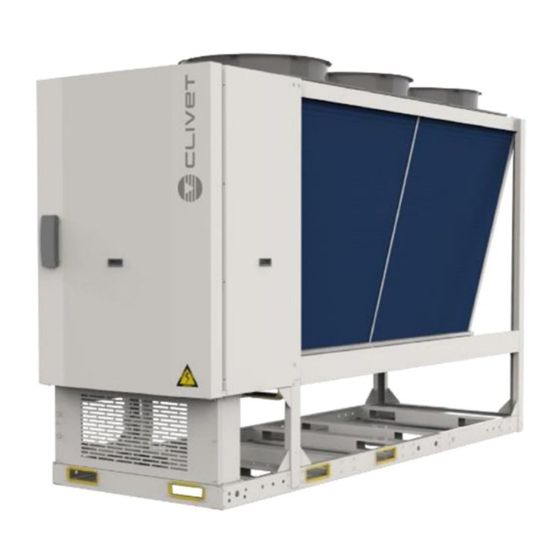
Table of Contents
Advertisement
Advertisement
Table of Contents

Summarization of Contents
General Information and Unit Identification
Manual and User Guidance
Provides essential information for unit installation, use, and maintenance.
Unit Identification and Specifications
Details about the unit's serial number, refrigerant type, and physical characteristics.
Information for the User
Guidance on keeping the manual, unit notebook, and handling malfunctions.
Unit Reception and Handling
Delivery Checks and Procedures
Verifying unit condition and correspondence with transport documents upon delivery.
Handling and Packaging Removal
Safe handling procedures and packaging removal instructions.
Unit Positioning Guidelines
General Positioning Considerations
Factors for unit placement, including weight, access, and connections.
Functional Spaces and Airflow
Requirements for unit operation and avoiding airflow obstructions.
Installation Standards and Safety
Ground clearance, leveling, condensation, snow accumulation, and safety zones.
Condensate and Valve Management
Handling condensate and pressure relief valve requirements.
Optional Protection Grilles
Information and diagrams for optional protection grilles.
Water Connection and Hydraulic System
Hydraulic System Design
Pipe design to limit pressure drops and optimize performance.
Water Quality Requirements
Criteria for water quality to prevent issues like pressure drop and corrosion.
Freeze Protection and Antifreeze Solutions
Measures to protect against freezing and guidelines for antifreeze use.
Domestic Hot Water (DHW) Option
Features and management of the DHW option, including priority.
Modular Configuration Water Aspects
TW probe, modular system control, and DHW management in modular setups.
Water Connection Operations
Sequence for starting the unit pump and water connection types.
Electrical Connections and Safety
General Electrical Requirements
Guidelines for electrical lines, protection devices, and operations.
Electrical Data and Wiring
Information from the serial label, technical bulletin, and wiring diagrams.
Signal, Data, and Power Lines
Cable routing, interference, power input, and remote ON-OFF controls.
Customer Electrical Connections
Diagrams and terminal descriptions for customer connections.
Modular Configuration Wiring and Addressing
Remote control, modular setup, and unit addressing for system control.
Modbus Communication Protocol
Modbus Functionality and Specifications
Reading/writing registers, RS-485 specs, unit addressing.
Modbus Register Mapping and Status
Detailed register lists for data, status queries, and fault codes.
Unit Start-Up Procedures
General Start-Up Requirements
Technician qualifications, data agreement, and preliminary checks.
Start-Up Sequence and Checks
Step-by-step process including refrigerant and water circuit checks.
Component-Specific Start-Up Tests
Checks for antifreeze, electrical circuit, heaters, pumps, and flow rate.
Multiple Configuration Start-Up Logic
How units start up sequentially in a modular system based on address.
Unit Control Interface and Operation
Control Panel Navigation and Functions
Understanding buttons, menus, and basic operations like unlocking and switching.
Control Panel Display Icons
Explains the meaning of various symbols shown on the unit display.
User Menu Settings and Configuration
Accessing and modifying query, timer, and hot water settings.
Advanced Control Settings
Configuring double setpoint, temperature compensation, and auxiliary heaters.
Troubleshooting and Error Codes
General Alarm Handling and Master Unit Issues
Resetting alarms, unit protection conditions, and master unit failures.
Error Code Descriptions (Sensors, Communication)
Detailed explanations for various error codes related to sensors and communication.
Error Code Descriptions (Pressure, Temperature, Logic)
Explanations for errors related to pressure, temperature, modules, and logic.
Status Display and Code Interpretation
Understanding the unit status display and interpreting status codes.
Maintenance Procedures and Safety
General Safety Warnings for R32 Units
Precautions for working with flammable refrigerants, area checks, and electrical safety.
Component Maintenance and Replacement
Cleaning and checking water exchangers, filters, pumps, fans, and coils.
Scheduled Inspections and Service
Guidelines for periodic inspections and recommended service intervals.
Unit Decommissioning and Disposal
Disconnection and Recovery Procedures
Safely disconnecting the unit, recovering refrigerant and antifreeze.
WEEE Disposal Regulations
Information on electrical waste disposal according to EU directives.
Residual Risks and Safety Precautions
Handling, Installation, and Electrical Risks
Risks associated with unit handling, installation, and electrical components.
Moving Parts and Refrigerant Hazards
Dangers from moving parts, fans, refrigerant exposure, and open flames.
Dimensional Drawings
Dimensions and Weights (Size 18.2 - 20.2)
Diagrams and table detailing physical dimensions and weights.
Dimensions and Weights (Size 25.2 - 35.2)
Diagrams and table detailing physical dimensions and weights.
General Technical Data
Performance Specifications
Heating, cooling, and AHRI performance data including capacities and efficiencies.
Construction and Calibration Data
Compressor, fan, water circuit specs, and control device calibrations.
Sound Level Data
Noise emission levels in different operating modes and conditions.
Operating Range Specifications
Graphical representation of unit operating limits for cooling and heating.
















Need help?
Do you have a question about the WSAN-YES 30.2 and is the answer not in the manual?
Questions and answers